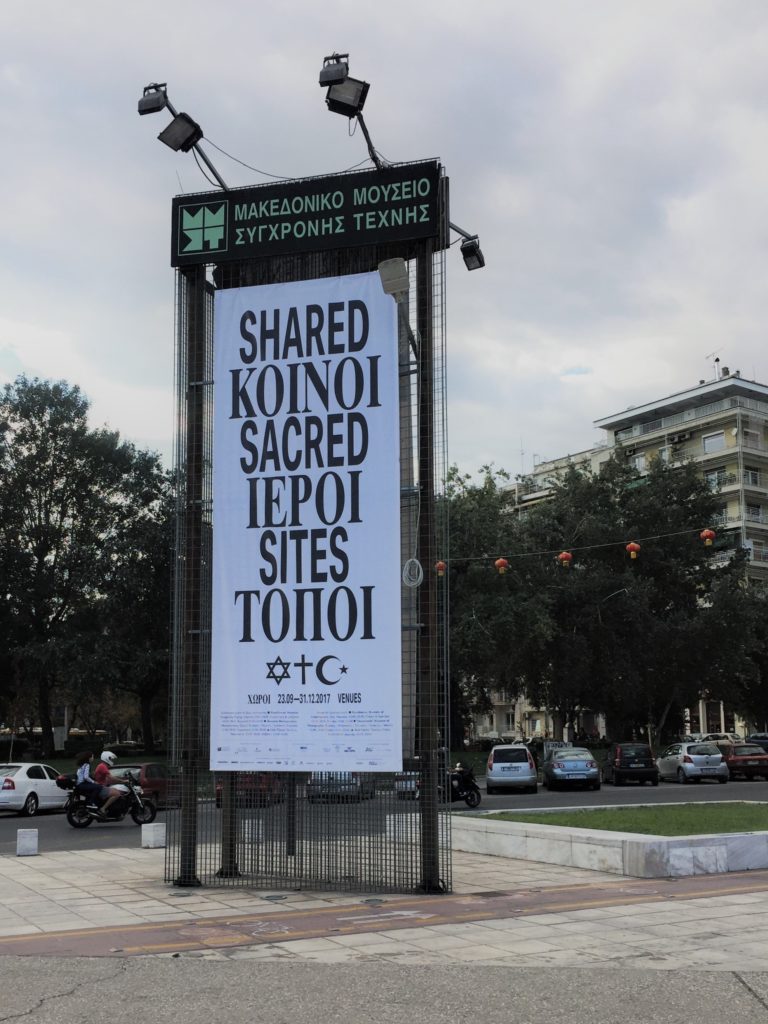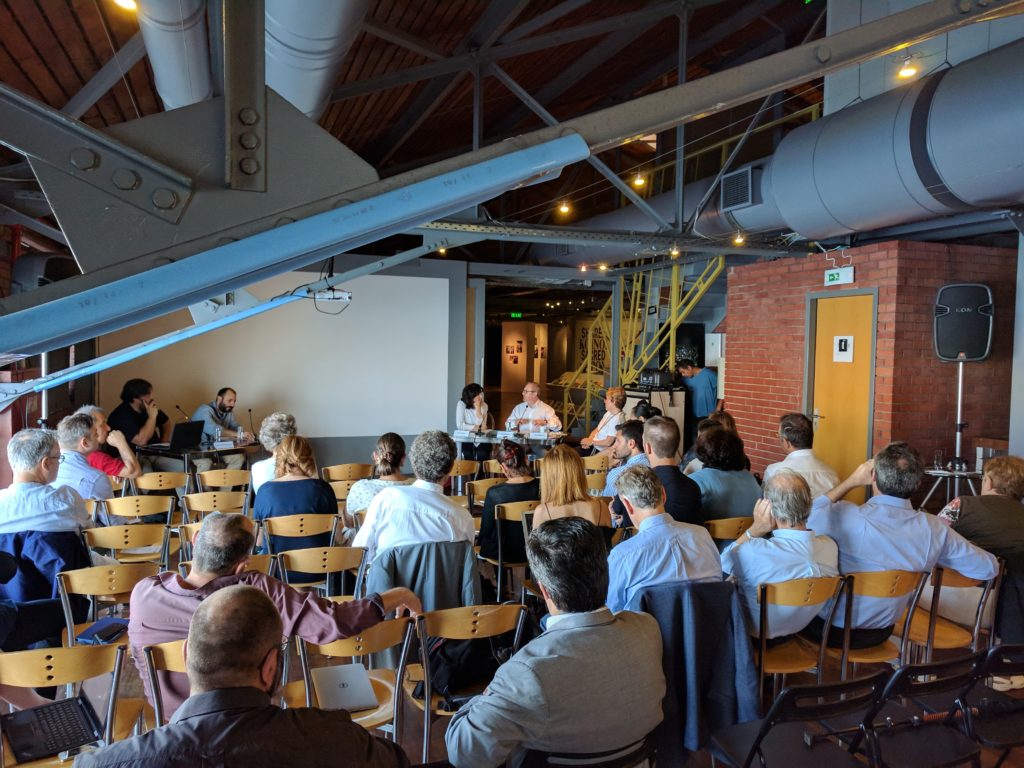
CONFLUENCE OF FAITHS:
SHARED SACRED SITES EXHIBITION IN THESSALONIKI, GREECE 2017
On September 23, 2017, we opened Shared Sacred Sites exhibition in Thessaloniki, Greece. Part of the international multi-year Shared Sacred Sites project, the exhibit engages the public in conversations about tolerance and coexistence among religious groups. This exhibition is hosted by three local institutions of art and culture: Thessaloniki Museum of Photography, Macedonian Museum of Contemporary Art, and Yeni Cami, and funded by generous grants from Stavros Niarchos Foundation and Nicholas J. and Anna K. Bouras Foundation. On the first day in Thessaloniki, the exhibition attracted hundreds of visitors.
History of “Shared Sacred Sites” Exhibition
“Shared Sacred Sites” is a touring exhibition that communicates the themes of religious tolerance among communities without defaulting to the hollow rhetoric of “a dialogue of cultures and religions.” The exhibition makes the experience of shared sacred sites accessible to new audiences, through a medium of multimedia exhibit featuring a variety of themes. The exhibition in France at the Museum of European and Mediterranean Civilizations (MuCEM) described: “it seems vital, amid debates about the clash of civilizations, to demonstrate that alienation and abhorrence of the other are not the required modalities of interaction between the religions of [the] Mediterranean.”
Significant to exhibition are also host-cities, which themselves are sites of convergence of multiple traditions and cultures. The exhibition was first launched in 2015, at the Museum of European and Mediterranean Civilizations (MuCEM) in Marseilles, France and drew more than 120 000 persons in four months. From November 2016 to February 2017, it was featured at the Bardo Museum in Tunis, Tunisia. On September 23rd 2017 it launched in Thessaloniki, Greece and will remain open until December 2017. In March 2018, “Shared Sacred Sites” will travel to New York City, NY. Exhibitions in Istanbul, Turkey and Berkeley, California are under development.
Thessaloniki, a city of sharing

Thessaloniki is a significant city in its rich history of diversity—religious and secular. Throughout the history of the Ottoman Empire, Thessaloniki was one of the most vibrant multi-ethnic and multi-religious trading cities of the empire. Its conviviality attracted all different religious communities and became known throughout the Empire. To this day, the city neighborhoods preserve vestiges of this interfaith cohabitation and collaboration.
Retracing the city’s multicultural past recently became even more vital amidst the rise of intolerant and exclusionary politics in different regions of the world. Once in the past, the city’s diverse character was violently dismantled by the annihilation of its Jewish population during the Nazi occupation. Today, the narratives of tolerance become particularly critical as Greece finds itself in the middle of a double financial and a humanitarian refugee crisis at the margins of Europe and at the crossroads of human flows and mobility across the Balkans and the Mediterranean.
Though this exhibition, we aim to revisit the city’s legacy of sharing, tolerance and diversity. Considering current debates of inclusion and exclusion, borders, encounters and interactions in Europe, the “Shared Sacred Sites” exhibition offers an alternative view of the Mediterranean as an open, shared and networked space and sheds light to both historical legacies of coexistence and contemporary cases of faith communities living and praying together.

The Three Sites of Exhibition
The three sites of the exhibit, The Macedonian Museum of Contemporary Art (MMCA), Thessaloniki Museum of Photography, and Yeni Cami reveal different aspects, both historic and contemporary, of “sharing the sacred.” We communicate the main themes of sharing through the photographic materials and films, modern and contemporary art pieces, ethnographic material, bibliographical sources that tell the stories of both the past and present of the crossovers of religious communities.
The Macedonian Museum of Contemporary Art (MMCA) exhibition provides the visitor with an experience that blends anthropological research and contemporary art. The anthropological encounter tells of shrines dedicated to prophets and patriarchs, to Mary and shared saints. The works of contemporary art, present a different locus for notions of sharing the sacred. Photographs, works of art, icons, and anthropological evidence are interwoven to evoke religious coexistence. With contemporary art, the exhibition raises questions concerning the power of religious symbols and practices that stand simultaneously at the core or at the edge of religion and faith.
At the Thessaloniki Museum of Photography (ThMP) the exhibition presents a visual journey through the diverse geographies and communities of the Mediterranean. Places of coexistence and active sharing are revealed, next to cases where territorial disputes lead to conflict and physical separation. The exhibition uses multiple photographic approaches, where archival material meets contemporary documentary photography and scientific fieldwork research blends with the vernacular photo keepsakes of the pilgrims and devotees themselves.
At Yeni Cami, the exhibition presents a historical narrative of Thessaloniki, privileging a religious osmosis that occurred between the three religions as they accommodated to living together. Daily contacts, popular religious interactions, testimonies of travelers and the coexistence in particular sacred spaces and iconic monuments of the city are highlighted as treasured fragments of an experience now lost and a memory largely erased: that of Thessaloniki as a city once shared by different ethnic and religious communities.
Below is a description of the exhibit in Thessaloniki Museum of Photography, reported by the museum’s news medium.
A journey through geographies and communities of shared sacred places
The exhibition at the Thessaloniki Museum of Photography unfolds in eight sections, where three distinct levels of photographic narration, one historic, one purely documentative and one artistic, are interwoven. We travel in regions where geography, history and tradition, social conditions and mixed communities crafted unique examples of cohabitation, of shared sacred sites and practices among groups of different religions.
Our tour begins from the “Holy City”, Jerusalem, sacred to all three monotheistic religions, where coexistence occurs, but in parallel and profoundly segregated ways. Divisions in the Holy Land become even more apparent in the section of the “Walls”.
The next sections on “Mountains” and “Islands” show us various communities, with lesser or greater isolation, from North Africa to the Aegean, where peaceful coexistence and the sharing of sacred sites constructed a common ground. Here the example of some Christian monasteries in Syria is high lightened as the confront the tragedy of civil war.
Through the numerous scattered “Sites of the Virgin” we encounter the timeless worship of Mother Mary by both Christians and Muslims, while in the section “Caves” we learn about exorcism rituals and about the legends of the Seven Sleepers that crosses through regions, cultures and religions.
Towards the end of the exhibition, the “In-betweens” of religious traditions and practices – and their hybridity – are explored in the Balkan region, while the makeshift worship places of immigrants in Greece are revealed in the section “From one coast to the other”, where a photographic project brings together diverse ethnic and religious communities and their experience.
To read the whole article click here.
Engaging the Public
Along with visual and interactive material, the exhibition also offers cultural events and performances that are open to the public.

On September 24th, “Shared Sacred Sites in the Balkans and the Mediterranean: International Workshop” was held at the Thessaloniki Museum of Photography as a part of the exhibition program, where international and domestic academics and artists discussed the state of religious pluralism and sharing in places of convergence of cultures.
On the opening date of the exhibition, Yeni Cami hosted a concert by Savina Yannatou, a talented singer, songwriter and composer, who captivated the crowd with her magical voice and exuberant charisma. Although her main repertoire consists of Greek traditional music, she also experiments with free jazz ans avant-garde styles.
Lessons from the Past
When religions converge, the resulting crossovers are not devoid of ambiguity and can sometimes also lead to conflict. But among the examples of partition and division in the Mediterranean worlds, there are also examples of inconspicuous and often silent sharing. The presence of shared sacred sites reveals the permeability of the frontiers between religious communities the dogmas of which seem incompatible.
The exhibition will be featured in Thessaloniki until December 2017. In parallel, the exhibition is adapted in Paris, France at the National Museum of the Immigration History from October 2017 to January 2018. In 2018, the Shared Sacred Sites project will reemerge in Marrakesh, Morocco at the Museum of the Confluences from December to March 2017. After Morocco, you can follow our exhibition in New York City, USA at three central cultural and educational institutions – New York Public Library, Morgan Library and Museum, and Graduate Center, CUNY – from March to July 2018.
Links
Center for Democracy, Tolerance and Religion
UC Berkeley Social Science Matrix
Main Curators:
Museums:
Thessaloniki Museum of Photography
Macedonian Museum of Contemporary Art
Thank You
We would like to thank Stavros Niarchos Foundation along with the Nicholas J. and Anna K. Bouras Foundation, and the Mayor and the City of Thessaloniki for making the exhibition possible.
Thank you to UC Berkeley Social Science Matrix‘s stellar Eva Seto and Rachel Park for their generous and invaluable help.
We thank the city of Thessaloniki for hosting us and sharing its story of coexistence and tolerance.
And, most importantly, the biggest thank you is to our visitors for joining us and making this exercise in sharing possible.
Below is the gallery of additional exhibition photos.

























